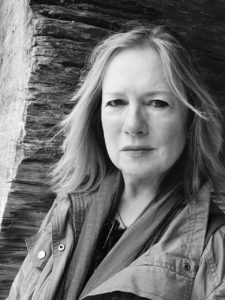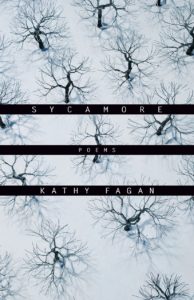 KATHY FAGAN’s newest book is Sycamore (Milkweed Editions, 2017). Her first collection, The Raft, won the National Poetry Series; her second, MOVING & ST RAGE, the Vassar Miller Poetry Prize. She has received fellowships from the NEA and Ohio Arts Council. Very recent work appears in The New Republic and Blackbird. Director of the Creative Writing Program at Ohio State, Fagan serves as Series Editor of the OSU Press/The Journal Wheeler Poetry Prize. Her website is http://www.kathyfagan.net. KATHY FAGAN’s newest book is Sycamore (Milkweed Editions, 2017). Her first collection, The Raft, won the National Poetry Series; her second, MOVING & ST RAGE, the Vassar Miller Poetry Prize. She has received fellowships from the NEA and Ohio Arts Council. Very recent work appears in The New Republic and Blackbird. Director of the Creative Writing Program at Ohio State, Fagan serves as Series Editor of the OSU Press/The Journal Wheeler Poetry Prize. Her website is http://www.kathyfagan.net. |
 Book Title, Press, Year of Publication:
Book Title, Press, Year of Publication:
Sycamore, Milkweed Editions, 2017
Synopsis: Sycamore is a book of close verse studies of the sycamore tree in all weathers, through seasons of lost love, grief, and recovery.
What do you think makes your book (or any book) a “project book”?
Sycamore is a project book in the sense that, for example, Stag’s Leap is a project book. It attempts to map the sudden and painful end of a long-term marriage—in my case, a same-sex marriage—through, in part, a real and metaphorical study of the common sycamore tree.
Why this subject (or constraint)?
This is a long strange story actually, which I’ll condense to these few details: when I first moved to Ohio I had a lengthy commute punctuated by trees I could not identify bordering fields and rivers. They were magnificent in every season, but especially winter, with their pearly bark and wildly tortured branches. Fast forward a dozen years or so to a more recent moment when I discover that the name of the tree I am so attracted to is sycamore, and instead of driving by them now I walk among them, photographing them throughout the year, researching the natural science and tracking the history and appearance of the tree in the arts. Sycamores thrive all over the world in almost all environments; they can be incredibly long-lived, and grow so large that humans have been known to live inside them. The bark, notable for its white sheen, sheds to allow for expansion. There’s something about those physical details, broken and strong and womanly all at once, that touches me. When the poems first emerged I called them self-portraits—one titled as such survives in the book—but I gradually understood that the poems were a series of studies, in the spirit of Monet’s haystacks and cathedrals. I became interested in recording the trees in conversation with the weather, the light, and the landscape, with both natural and human history. When my long-term relationship ended abruptly, I turned to the trees—and to the poems—for shelter. And both accommodated me.
Was your project defined before you started writing? To what degree did it develop organically as you added poems?
Interrogating the character of the sycamore allowed me, as persona also can, a certain freedom, a principle by which to observe and listen, feel and say. So as the focus shifted to my personal loss, I trusted the process to work itself out. When I was writing my second book, MOVING & ST RAGE, a close friend, who was like a mother to me, became ill and died. I stopped writing then for more than a year. When I began again, the poems seemed completely unlike, to my mind, the poems I’d already collected. I fretted about that until I found a way to braid both sets of poems. There was a way—and I was that way. I learned to trust then that the poems, all of them, are mine. I think the emergent era of creative nonfiction as a genre provided poets an assist with that permission to braid or blend narratives and disparate impulses in poems.
How important was it for you that each poem could “stand on its own” or that the poems should rely on other poems in the book, or on the premise of the project itself, to succeed? What challenges did this present for you when writing single poems or structuring the book overall?
My MFA students and I talk about this all the time. It’s so hard to know, when you’re immersed in a book—for them, the thesis that will in some form become the book—if the poems are working together or apart or, ideally, both. Old school logic tells me one should focus on the poem, as one focuses on the line: one at a time. But I also see the logic in weaving strands of poems together, by way of related imagery, structure, syntax, and subject matter. I don’t see any good reason—other than editorial ones—to be militant about poems standing on their own. I want my poems to do that because their autonomy is meaningful to me, but I don’t demand my mature poetry students follow suit—that would be prudish and invasive.
At any point did you feel you were including (or were tempted to include) weaker poems in service of the project’s overall needs? This is a risk, and a common critique, of many project books. How did you deal with this?
I don’t generate quite enough material for that to be a major problem for me, but I did take out about a dozen poems from Sycamore when the time came to submit it. For me it wasn’t so much a matter of project needs as it was a matter of what sang to me and what didn’t. In other words, the lesser poems needed to leave the manuscript and, frankly, the planet, too.
As a reader, are you drawn to project books? What project books have influenced you or have you enjoyed, and what do you think makes those books successful?
Gluck’s The Wild Iris with its emphasis on nature is definitely a progenitor to Sycamore; I mentioned Olds’s Stag’s Leap. I still very much love Kinnell’s The Book of Nightmares, Doty’s My Alexandria, Dove’s Thomas and Beulah. More recently, of course, there’s Kiki Petrosino, Idra Novey, and Tarfia Faizullah. In every case, whether the “project” is rangy or specific, structural or thematic, a commitment to research and the creation of a writerly cosmology seem key.
What effect do you think the prevalence of project books is having on poetry in general?
We live in sound-byte days. It’s good and bad that we can summarize a book by saying what its project is, but that’s a marketplace consideration above all, not an artistic one. I frankly didn’t consider either my study of the sycamore or the end of my long-term relationship “projects”—they were elements that consumed my days and nights and bled over into my artistic life, and as such they entered the poems, shaped the poems, and my vision of what the poems could be. I’m grateful for that experiment and exploration.
After completing a project, how did you transition into writing something new? What are you working on now? Another project?
Yes, I’m very much involved in the sixth manuscript. I had to leave Sycamore, quite literally. I mean, I wrote a goodbye poem to the book, a poem that’s included in the book (hint: not the final poem of the book), in order to put an end to it. I still visit my trees and feel a terrifically strong spiritual connection to and reverence for them, but my attentions are strongly focused on the next book, over half finished, tentatively titled Animal Prudence. It’s a book engaged with multiple levels of perception and predation. Perception itself is a predatory act, and to make poetry, I feel, attempts to keep fresh the wounds of the prey.
What advice can you offer other writers, particularly emerging writers or poetry students who may be using the project book as a guiding principle for their own work?
For me the sycamore was just a sort of crush at first: a charmed and beautiful object. That attraction led me to research and discovery, not just about the tree but about art and history, myth and the natural sciences—in other words, the immersion led me to a system of image- and language-making, the writerly cosmology I spoke of earlier. There are other processes to different project books, but as far as I know they all require complete immersion.
When I first began to give readings from my Sycamore manuscript, a prose writer colleague of mine joked that the best way to introduce them would be to say: “I’m going to read you some poems about trees and some poems about a bad break-up. See if you can tell which is which.” Poems are hard and almost always working outside the more logical parameters of prose, and frequently even beyond those parameters because of the resonances of metaphor and the line. Poems’ narratives are often interiorized, their structures sometimes disguised. If an obsession or passion—my notion of what is meant here by project—helps to guide you through those complexities of art-making, why wouldn’t you make use of it? Any way you can get the poem to the page and discover something about yourself and your craft in the process is a good way, yes?

